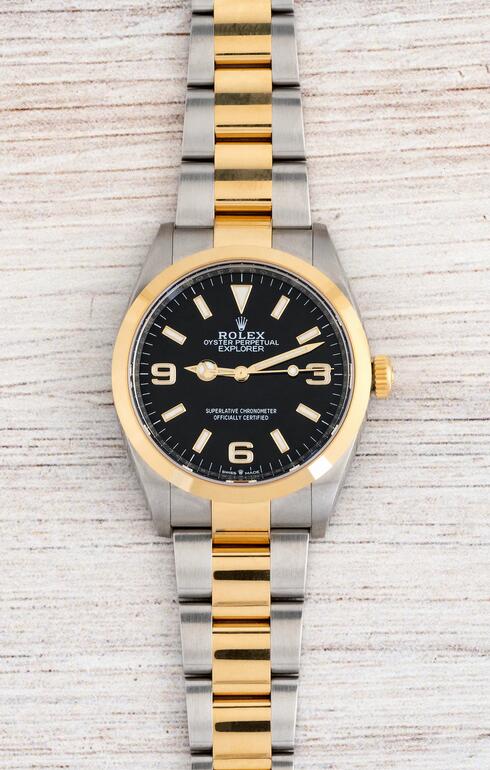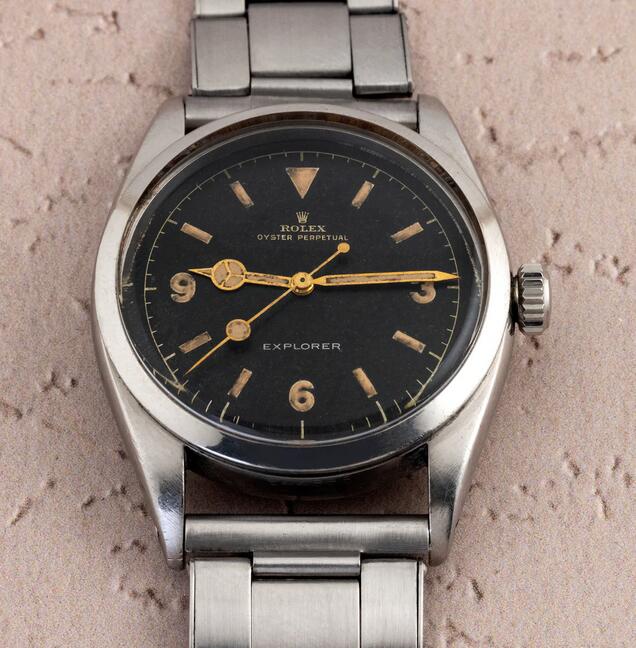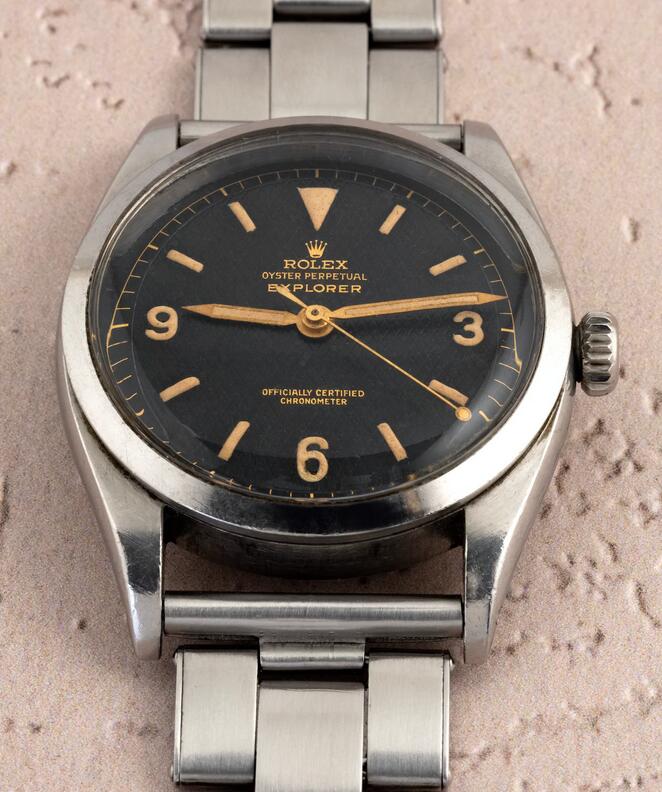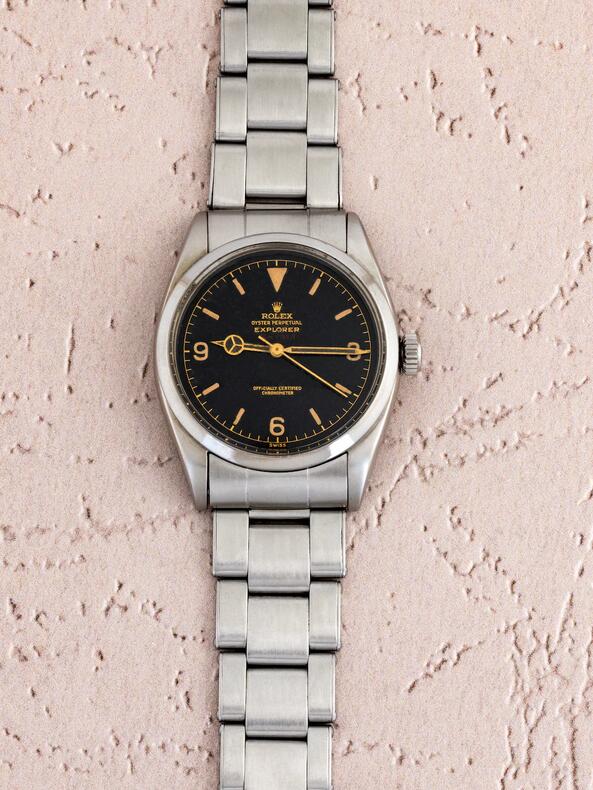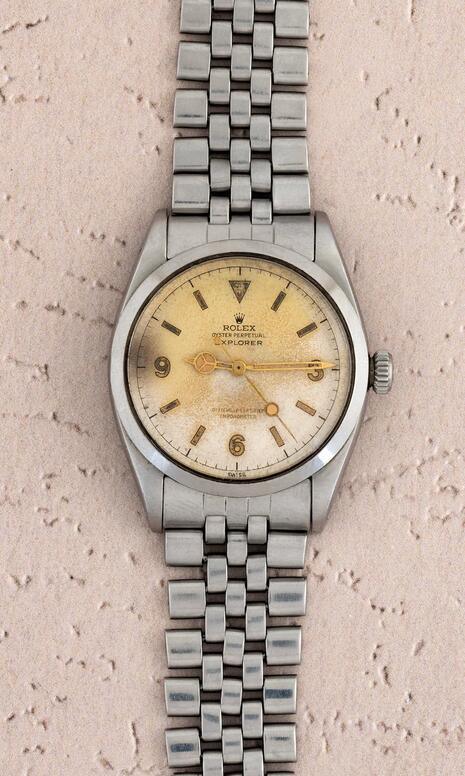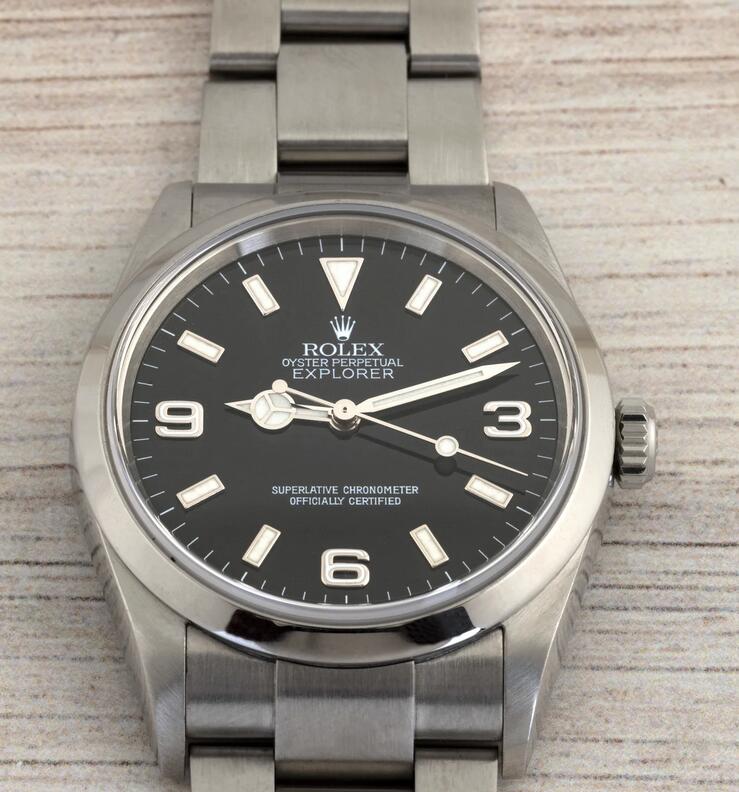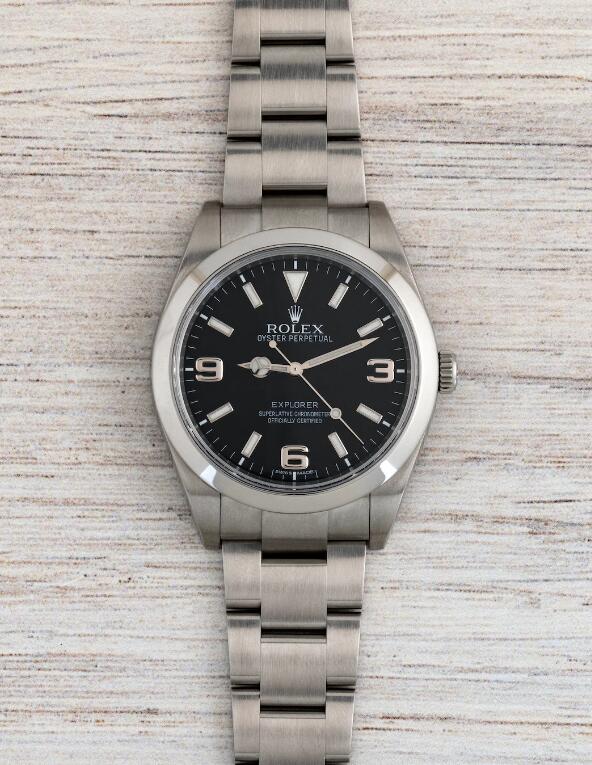With its three-hand simplicity and discreetly wearable size, the luxury Rolex Explorer replica watches is, more than any of the Crown’s sport watches, the one that skirts the line dividing the tool watch from the dress watch. And yet it’s also a Rolex most plainly made for legibility in adverse conditions and exposure to the elements.
Born for high-altitude Himalayan climbing, the Explorer arrived in 1953, the same year as the Submariner and the Turn-O-Graph. To say it was a major year for Rolex, and for 1:1 best Rolex fake watches more broadly, would be an understatement. It shaped the watch company that Rolex would become, the sport segment as we know it, and the watch-collecting pyramid that Rolex sits atop.
The Explorer has come to embody what many see as the ideal “one nice watch” to own. Its simplicity and classic design allow it to go anywhere, not only far-off mountaintops. And the reference 1016 in particular, which spanned an incredible 29 years of production, from 1960 to 1989, stands as a true vintage hall-of-famer. With its subtle 36mm size, no-date simplicity, and crisp black dial – whether gilt or matte – it’s the sport Rolex that doesn’t turn heads – the anti-hype Rolex, if you will. The “if you know, you know”perfect US replica Rolex watches.
At auction, quality Explorer examples bring in respectable sums, but nothing like the Submariners or the Daytonas of the world. In fact, if you search online for Explorer records at auction, you’re likely to return many results for Explorer-dial Submariners bearing the 3-6-9 dial. The Explorer is a humble watch for a Rolex professional model launched 69 years ago. And yet it was the Rolex worn by Ian Fleming, and the one he was most likely thinking of when he decided which watch James Bond would wear.
Today, the Explorer is something of an outlier within the modern Rolex sport watch lineup. Its compact dimensions have hewn to the midcentury design of its birth with only occasional detours, such as when it was temporarily beefed up to 39mm in 2010 with the reference 214270. Since then, the Explorer has returned to its 36mm roots, albeit with another unexpected curveball thrown at collectors, the option of a two-tone case and bracelet. As the smallest, simplest, and most consistent of the cheap copy Rolex professional watches, the Explorer isn’t really here to surprise or wow us – so when it unexpectedly does just that, the effect is phenomenal.
I’ve provided production dates for the references in this article wherever I could. But it is important to understand that the numbers on the inside caseback tell us about case production. Often, wholesale replica watches weren’t assembled until a year later and then sold after that, in some cases many years later. In the mid-’70s, Rolex stopped putting case production dates on the inside casebacks of their watches. Serial numbers printed between the lugs offer the best insight into when those watches were made, but this is also something of an imprecise science.
Origins In Exploration
Just as the Rolex Explorer fake watches for men itself requires no introduction to watch lovers, neither does the story of its genesis. In late May 1953, Tenzing Norgay and Sir Edmund Hillary became the first alpinists to conquer the world’s highest peak, and found themselves instantly catapulted into the history books. On their expedition they carried the Rolex chronometer, below, today considered a Pre-Explorer, which now lives in Zurich’s Beyer Museum below a multigenerational family-owned watch shop. You can buy a ticket and see it for yourself.
We look at Rolex’s associations through the years – with commercial aviation, diving, militaries, and the arts and more – and see a deft marketer’s touch, a propensity to be early or first, and very often simply present when great people achieved great things. In supporting Hillary and Norgay as they climbed to history, Rolex established itself as a maker of Swiss movements replica watches that could go the extra mile and be taken into the world’s most harrowing circumstances with confidence. And they were well-prepared for the watches that would come next. The Crown registered the trademark for the Explorer name in January of that year.
Now, it bears mentioning that while Hillary and Norgay indeed had a watch from Rolex in their kit, they also had another, from the English brand Smiths. Both brands sponsored the bid to reach the peak of Everest. Citing period evidence, an article in Outdoor Journal concluded that it was a Smiths watch, and not a Rolex, that made it all the way to the summit. Regardless of whether a Rolex made it to the top, there can be no doubt that it was Rolex and its Explorer that capitalized most on its association with the expedition.
The same year as Norgay’s and Hillary’s expedition witnessed the introduction of the reference 6350, the first watch to feature the name Explorer on the dial for all examples. In many instances, its predecessor, the 6150, says Precision in place of Explorer, causing many to refer to it as a pre-Explorer, as well. But we happen to have a 6150 Explorer for this edition of Reference Points (it’s also in the video, above, co-starring gentleman-dealer Eric Wind), so we’ll begin our climb through the history of the world’s most famous go-anywhere watch right there.
Reference 6150 (1952-1953)
Reference 6150 (Explorer Above 6:00, Long Hour Hand)
The Reference 6150 is the immediate predecessor to the reference 6350, the watch that many collectors argue is the first Explorer. Traits that will typify the Explorer through the years are already here. Produced from 1952 / 1953, the Reference 6150 has the same 36mm size we see through all of the rest of the 20th century and much of the 21st, up to and including today’s current Rolex Explorer super clone watches online store. The reference 6150 is similar to the 6098 and 6298. While it features the 3-6-9 layout that would go on to be called the Explorer dial, only some feature a line of text above six o’clock reading “Explorer.” The rest, and indeed the majority, say “Precision.” The example we see here is one of the former, and it also features a long hour hand. One thing you will notice is that there is no OCC text on the dial. That’s because this watch is not a chronometer, further separating it from the rest of the Explorers. The fact it is not a chronometer and that not all of this reference say the word “Explorer” on the dial has meant that some collectors do not consider the reference 6150 a true Explorer.
Reference 6350 (1953 to 1955)
Reference 6350 (Pencil Hands, Waffle Dial)
The immediate successor to the 6150 is the reference 6350 – which everyone agrees is an Explorer, and that some argue is the first Explorer I. This example has a textured waffle dial, also known as the honeycomb dial, named for its patterned surface. While the waffle dial can be found on other Rolex replica watches site from the period, the 6350 is the only Explorer reference in which it figures. Our example has pencil hands, though there are also 6350s with Mercedes hour hands, sometimes with a syringe minute hand. Most of the examples we see have an inside caseback number that indicates the case was produced in 1953; however, it seems they were assembled over a period of several years after that.
The 6350 is an officially certified chronometer, a worthwhile point of distinction from the 6150, one watch earlier. When one talks about the Rolex Explorer, one is really talking about a chronometer. The Explorer has no complications, it has no fancy bells and whistles. Until just last year, it had only a single metal to its name – stainless steel. It is about as basic as a Rolex professional model gets, and telling time accurately and legibly is the name of the game.
For the most part, the luxury fake watches we will be looking at today are chronometers: Officially Certified Chronometers in the first grouping, and Superlative Chronometer Officially Certified once we get to our first 1016 in this article. We’ll see a few additional non-chronometers, but those watches aren’t technically Explorers. Read on to learn more.
Reference 6610 (1955 to 1959)
Between 1955 and 1959, Rolex produced the reference 6610, the last of the older batch of Explorers that would eventually give way to the 1016, one of the longest-running Rolex watch references ever. We have four special examples of this reference, which is far rarer than the 1016 as it was made for a dramatically shorter period of time. You’ll notice that the text above 6 o’clock on each of the following four perfect replica watches reads “Officially Certified Chronometer” like the OCC text of the 6350 before it.
Reference 6610 (Red Depth Rating): 1955 to 1956
Some of the earliest Explorer reference 6610 examples feature a very subtle red depth rating (50m = 165ft) just below the word Explorer in the upper half of their dial, a style of marking seen in other high quality fake Rolex sport watches from the period, including the GMT-Master reference. 6542, Datejusts, and even 34mm Oyster Perpetuals, reflecting marketing efforts to share their water-resistant characteristics more broadly during the early days of dive watches for commercial purchase.
Here are two very nice examples of early Explorers with depth ratings sold by Phillips, one with a red depth rating and the other with a gilt depth rating.
Reference 6610 (Albino)
Next we have a white, or “Albino,” version of the 6610, one of the rarest and most valuable Explorer variations. There are also GMT-Master reference 6542s with white “Albino” dials from this era, as well as Submariners. Later “Albino” reference 1016s have come to market. This particular Albino 6610 dates to 1957.
Reference 6610 (Lollipop Seconds Hand, Chapter Ring): 1957
This brings us toward the end of the 6610 run. The Explorer has traditionally been a watch made for maximum legibility in low-light conditions, and here we see a large white luminous seconds hand, similar to the lollipop seconds hands on some Submariners with a case production of 1957.
Reference 6610 (Smaller Lume Circle On Seconds Hand): 1959
Finally, we have the very last version of the 6610, where the luminous circle is smaller than in the previous version. This version also has a rare “Big Logo” bracelet.
The Rolex Explorer Reference 1016 (1960 to 1989)
The conclusion of the 6610 brings us to the beloved reference 1016, the one most vintage lovers think of when their mind goes to the Explorer I.
With the 1016, we see the introduction of “Superlative Chronometer Officially Certified” text on the dial, which accompanies the transition from the caliber 1030 to the new caliber 1560 microstella-adjusted movement. Later, in the mid-’60s, Rolex will upgrade to the high-beat-for-its-time caliber 1570, which runs at 19,800 vph compared to the 18,000 vph caliber 1560. In the early 1970s, Rolex added a hacking feature to this movement, which would continue to power the 1016 until the end of its production run in 1989.
We’d like to thank collector Andrew Hantel for his detailed research into this reference, which can be found on his excellent and aptly named website devoted to the reference, Explorer1016.com.
After we chart the long and storied course of this fan-favorite reference, we’ll hear from prominent collectors who will tell us why they love the Rolex Explorer reference 1016.
Reference 14270 (First Version, Blackout): 1989 to 1991
Here we are with the first 14270, the watch that took up the Explorer mantle upon the retirement of the 1016. The classic 36mm size that has defined the Explorer since its early days remains, as do the 3-6-9 numerals. But whereas the 1016’s numerals were painted on, the 14270 sees the introduction of higher-end applied markers and numerals. The 14270 isn’t shy about the fact that it’s a luxury tool watch with a distinctive modern flair. The Blackout’s namesake attribute is the black lacquer filling its applied numerals, lending a somewhat stealthy vibe to the dial (though the markers are still lume-filled). From the beginning, the Explorer had been viewed as a no-frills, go-anywhere tool watch, but this model came with a design that compromised low-light legibility for the sake of style. As such, it’s something of an outlier. It’s also incredibly collectible, costing much more than the rest of the China replica watches we will be looking at within the reference 14270 range. The blackout is a very rare model by Rolex standards, found only in late-E and early-X serial numbers, giving them a production range of 1989 to 1991.
Reference 14270 T-Swiss (Drilled lugs): 1991 to 1994
Immediately following the “Blackout,” we have the T-Swiss, the longest-running variant of 14270. With the exception of some very late U-series models, the T-Swiss has tritium-filled hands and indexes, as the nickname would indicate. Much like the 14270 more broadly, the T-Swiss inhabits a murky middle period in fake watches paypal. Like all 14270s, the T-Swiss has a crystal of sapphire and its movement is the caliber 3000, but only the first three years of production have fully drilled-through lugs. Starting in 1994, plain, or undrilled lugs became the order of the day. The 14270 is a reference that manifests the process by which Rolex became the modern watchmaker it is today.
Reference 14270 T-Swiss (Closed lugs): 1994 to 1998
Starting in 1994, plain lugs became de rigueur, one more modern feature taking the place of a design element associated with the vintage era. The 14270 is a reference that shows the process by which Rolex became the modern watchmaker it is today. From here on out, all 14270s – and all Explorers, for that matter – will feature undrilled lugs.
Reference 14270 Swiss Only: 1998 to 1999
And here we have the penultimate variation of the 14270, the Swiss Only, made for a brief period of time right at the tail end of the ’90s. By now, photo-reactive LumiNova has taken over, and with the absence of tritium, the tenuous connection to vintage best quality replica watches is gone. Like the later T-Swiss models, the Swiss Only has plain lugs.
After the Swiss Only, in the final two years of the 14270 (1999 to 2001) we will see the Swiss Made, the watch that followed the one here. Its name indicates the use of Super-LumiNova, which would continue into the next Explorer reference, the virtually identical 114270.
Reference 114270 (2001 to 2010)
Like the last 14270, the 114270 uses Super-LumiNova. And features a 36mm case. And has “Swiss Made” written at the 6 o’clock position. What sets them apart is this watch’s use of the upgraded caliber 3130 and solid end links. This is something that we see from time to time with Rolex. Changes are made incrementally, and sometimes that means the only upgrades in a new watch are hidden away behind a layer of steel.
The 114270 had a near-decade-long run, its subtle improvements over the 14270 having seemingly been enough to make Rolex see fit to leave the Explorer be for a while, though there was the addition of an engraved rehaut late in the production of this model. But after about 21 years of extremely consistent Explorer design, and 57 years of rigid adherence to the 36mm case size, things were about to change. Big time.
Reference 214270
Reference 214270 Mark 1 (2010 to 2016)
In 2010, Rolex did something unexpected. For the first time in the more than 50-year history of the Rolex Explorer, the Crown’s simplest and most discreet stainless steel sport watch, known for bridging tool-watch toughness and dress watch dimensions, tipped the 36mm scale. Looking back, it’s surprising that it took this long.
The 214270 saw its own movement upgrade, this time to the caliber 3132. The movement was based on the 3130 we’ve already seen, but is endowed with Rolex’s in-house shock system and Parachrom hairspring. The first six years of production featured a configuration in which the 3-6-9 Explorer numerals were uncoated white gold, with no white paint to heighten legibility. The handsets seemed short with respect to the dial’s diameter, and were widely panned by the watch-collecting community.
Reference 214270 Mark 2 (2016 to 2021)
The handset was redesigned in 2016 in order to better fit the dial, and the numerals were once again applied metal, only now they were filled with lume. With the Mark 2 variation, the design was improved, and there was no reason to believe that Rolex had any intention other than to methodically improve upon the Explorer, as it had already done for decades, in its new modern sport watch size.
The Current Generation
Last year brought yet another surprise. Actually, two. The Explorer returned with an all-new reference, the 124270. Rolex upgraded its simplest sport watch to the current generation of automatic movements with Chronergy Escapement and 70 hours of power reserve. But that wasn’t a surprise. The first surprise came with a return to the tried and true, and beloved by watch enthusiasts, 36mm case. After an 11-year diversion, the Explorer was back where nerdy watch lovers wanted it. The second surprise, a big one, was a second model. A Rolesor model. AKA the Two-Tone Explorer.
Reference 124270 (2021 to present)
As with every trade show in which Rolex participates, the watch world had their eyes focused on the Crown as the 2021 edition of Watches & Wonders began. Everyone, it seemed, wanted to know what they would do next. The chatter that year focused mostly on the Explorer I’s cousin, the Explorer II, which was celebrating its 50th anniversary. And though the Explorer II did indeed receive a number of incremental updates, it was what Rolex did with the Explorer I that garnered the most headlines. Returning its simplest Professional watch to its previous 36mm size proved popular with enthusiasts, a move that came along with a number of more predictable and less exciting enhancements. The movement was now the caliber 3230 with Chronergy Escapement and a healthy 70 hours of power reserve. This watch is remarkably similar in appearance to the erstwhile 14270 and 114270 models. The quickest tell is the Rolex Coronet between Swiss and Made, at the 6 o’clock position.
Reference 124273 (2021 to present)
This is the shocker, and the piece that everyone still seems to be obsessed with nearly a year after its release. From its early days, the Explorer was the no-nonsense tool watch with chronometer-rated automatic movement. Its principle function was to deliver the time legibly and accurately to a wearer who had more serious concerns than the safety of his a precious luxury watch. And yet, the Explorer has on very rare occasions gestured to style at the expense of sheer performance or durability. Remember the “Blackout” variation of the reference 14270, with its numerals in dark lacquer set against a glossy black dial? What’s easily the most collectible 14270 variation isn’t the easiest 14270 to read in low light.
The new Rolesor top online fake Rolex Explorer is the watch that fully acknowledges that, despite images like this viral one taken by Nims Purja, most of us are never going to climb Everest. Rolex is a luxury brand, and the Explorer is another of the Professional models that have become virtually impossible to find at retail stores. Now that Rolex has taken the Explorer in an unexpected two-tone direction, the real question is whether there will be a fully gold Explorer. It’s a question only time can answer. Our friend and longtime colleague Stephen Pulvirent spent a week with the Rolesor Explorer.
